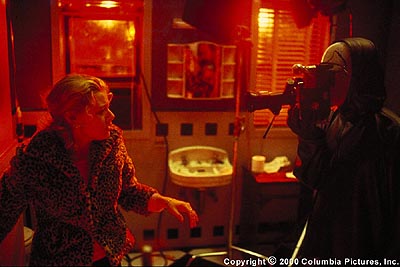

It takes a lot for a sequel to truly surpass its predecessor. In the case of Urban Legends, the bar is relatively low. Still, Urban Legends: Final Cut does not rise to the occasion. This is an attempt to make a franchise out of something that should not have a franchise. This movie is also barely a sequel. If producers decide to make more films, they have an easy time. The plot can stay the same each time. In a college campus, there is a serial killer killing people using urban legends. There are always new urban legends created. The films don't even need to have the same characters. Only one, Reese, makes a return appearance. In other words, this is a franchise that can be a cheap way to put telegenic young actors on movie screens before their inevitable series on the WB network.
Amy (Jennifer Morrison, Stir of Echoes, Intersection) is a film student in dire need of a movie. Reese (Loretta Devine, Down in the Delta, Hoodlum) suggests that she base it on urban legends, and lo and behold, actual murders begin happening. Travis (Matt Davis, Tigerland, Pearl Harbor) commits suicide, but Amy believes it is something more sinister. Luckily, his twin brother, Trevor shows up and vows to help Amy. Also on the list for potential suspects are Graham (Joseph, not Joey, Lawrence, Tequila Body Shots, Desperate But Not Serious), the old-money producer, Vanessa (Eva Mendes, My Brother the Pig, A Night at the Roxbury), Toby (Anson Mount, What Happened to Tully), a rival student filmmaker, and a whole bunch of other people who end up as serial killer fodder.
It is a shame that this film takes place in a film school. Writers Paul Harris Boardman and Scott Derrickson (Hellraiser Inferno) obviously know their film history and technique. They mention Hitchcock, Truffaut, Welles, cinema verite and mise en scene. Sadly enough, the student films are horrible. Admission requirements to this film program must be very low. Having the film take place at a film school is also a cheap excuse to use a whole bunch of unrelated settings. Murders occur in soundrooms, bathrooms, mine shafts and a cemetery.
The urban legends are also not compelling. With so many floating around, at least the writers and director John Ottman could have come up with something better. Some of the more familiar ones they choose are already passed around to death over e-mail, and watching on the screen is boring. They rely solely on gruesome murders and random noises and animals to generate suspense instead of actual suspense. Two sequences are obviously not real killings (within the movies) but movies filming. One main point is to keep the audience guessing as to the identity of the killer. The story is a cop out. The killer's reasons for killing make no real sense, and it is nearly impossible to guess his/her identity. In fact, no one really cares who did the killing by the time the end rolls around.